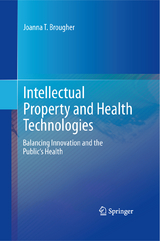Intellectual Property and Health Technologies
Balancing Innovation and the Public's Health
Seiten
2013
|
2014 ed.
Springer-Verlag New York Inc.
978-1-4614-8201-7 (ISBN)
Springer-Verlag New York Inc.
978-1-4614-8201-7 (ISBN)
Intellectual Property and Health Technologies
Balancing Innovation and the Public's Health
Joanna T. Brougher, Esq., MPH
At first glance, ownership of intellectual property seems straightforward: the control over an invention or idea. But with the recent explosion of new scientific discoveries poised to transform public health and healthcare systems, costly and lengthy patent disputes threaten both to undermine the attempts to develop new medical technologies and to keep potentially life-saving treatments from patients who need them.
Intellectual Property and Health Technologies grounds readers in patent law and explores how scientific research and enterprise are evolving in response. Geared specifically to the medical disciplines, it differentiates among forms of legal protection for inventors such as copyrights and patents, explains their limits, and argues for balance between competing forces of exclusivity and availability. Chapters delve into the major legal controversies concerning medical and biotechnologies in terms of pricing, markets, and especially the tension between innovation and access, including:
The patent-eligibility of genes
The patent-eligibility of medical process patents
The rights and roles of universities and inventors
The balancing of access, innovation, and profit in drug development
The tension between biologics, small-molecule drugs, and their generic counterparts
International patent law and access to medicine in the developing world
As these issues continue to shape and define the debate, Intellectual Property and Health Technologies enables professionals and graduate students in public health, health policy, healthcare administration, and medicine to understand patent law and how it affects the development of medical technology and the delivery of medicine.
Balancing Innovation and the Public's Health
Joanna T. Brougher, Esq., MPH
At first glance, ownership of intellectual property seems straightforward: the control over an invention or idea. But with the recent explosion of new scientific discoveries poised to transform public health and healthcare systems, costly and lengthy patent disputes threaten both to undermine the attempts to develop new medical technologies and to keep potentially life-saving treatments from patients who need them.
Intellectual Property and Health Technologies grounds readers in patent law and explores how scientific research and enterprise are evolving in response. Geared specifically to the medical disciplines, it differentiates among forms of legal protection for inventors such as copyrights and patents, explains their limits, and argues for balance between competing forces of exclusivity and availability. Chapters delve into the major legal controversies concerning medical and biotechnologies in terms of pricing, markets, and especially the tension between innovation and access, including:
The patent-eligibility of genes
The patent-eligibility of medical process patents
The rights and roles of universities and inventors
The balancing of access, innovation, and profit in drug development
The tension between biologics, small-molecule drugs, and their generic counterparts
International patent law and access to medicine in the developing world
As these issues continue to shape and define the debate, Intellectual Property and Health Technologies enables professionals and graduate students in public health, health policy, healthcare administration, and medicine to understand patent law and how it affects the development of medical technology and the delivery of medicine.
Chapter 1 Introduction to Intellectual Property.-Chapter 2 Obtaining, Enforcing and Defending Patents.-Chapter 3 The Patent- Eligibility of Genes.-Chapter 4 Medical Procedure Patents.-Chapter 5 Rights and Roles of Universities and Inventors.-Chapter 6 Drug Development: Balancing Innovation, Access and Profits.-Chapter 7 Patent Battles-Small-Molecule Drugs.-Chapter 8 Biologics and Biosimilars: Balancing Access and Innovation.-Chapter 9 International Patent Law, Trade Law, and Access to Drugs.
| Erscheint lt. Verlag | 7.11.2013 |
|---|---|
| Zusatzinfo | 8 Illustrations, black and white; XV, 214 p. 8 illus. |
| Verlagsort | New York, NY |
| Sprache | englisch |
| Maße | 155 x 235 mm |
| Themenwelt | Studium ► Querschnittsbereiche ► Prävention / Gesundheitsförderung |
| Recht / Steuern ► EU / Internationales Recht | |
| Recht / Steuern ► Privatrecht / Bürgerliches Recht ► Medizinrecht | |
| Recht / Steuern ► Wirtschaftsrecht ► Urheberrecht | |
| Schlagworte | Access to Medicines • Drug patents • Gene patents • Generic drugs • Global Public Health • Intellectual property and drug development • Medical process patents • Pharmaceutical Industry • TRIPS Agreement |
| ISBN-10 | 1-4614-8201-1 / 1461482011 |
| ISBN-13 | 978-1-4614-8201-7 / 9781461482017 |
| Zustand | Neuware |
| Haben Sie eine Frage zum Produkt? |
Mehr entdecken
aus dem Bereich
aus dem Bereich
das Manual zur psychologischen Gesundheitsförderung
Buch | Hardcover (2023)
Springer Berlin (Verlag)
39,99 €
Orthomolekulare Medizin in Prävention, Diagnostik und Therapie
Buch | Hardcover (2022)
Thieme (Verlag)
71,00 €




